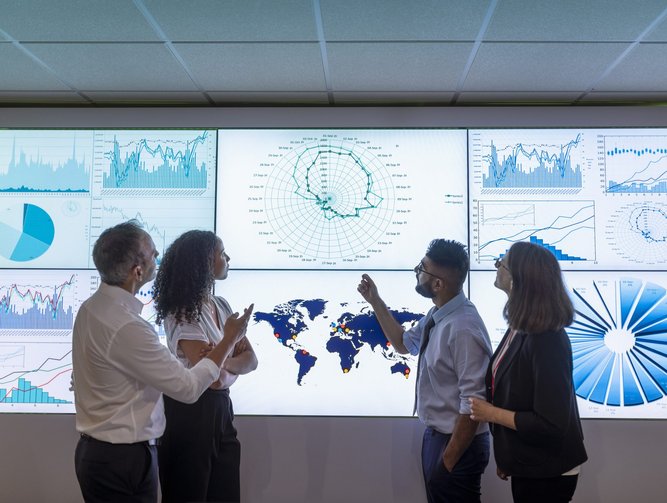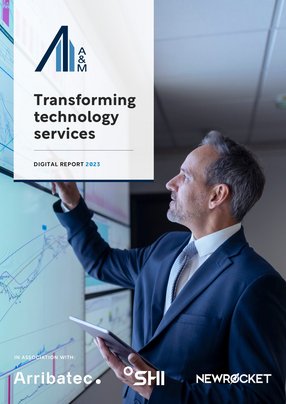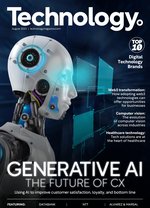Supporting a global professional services firm that enables world class organisations presents many opportunities and challenges for an Information Technology function. Supporting such an organisation requires intense focus and high flexibility. These environments leave little time to be introspective and require a CIO to make instantaneous decisions and constantly evolve their thinking. Working in such a highly dynamic and fluid environment has never been a problem for flexible CIOs such as Jeremy Zung, Chief Information Officer (CIO) for Alvarez & Marsal (A&M).
“When I joined A&M during COVID, there was no playbook or manual to tap into,” he says. “It became very clear, though, that our primary focus needed to be about stabilising the core – this included not just technology, but our staff. We had a lot of technical debt that had built up, similar to many companies.”
As global CIO, Zung is responsible for all internal IT matters including all back-office technologies and systems. Once the core was stabilised, it allowed the focus to quickly move to improving services to A&M’s growing base of global professionals. Transforming the IT department required a change of mindset to operate IT as a business.
Founded in 1983, A&M provides advisory, business performance improvement, and turnaround management services to a diverse range of clients – from corporates and government agencies to private equity firms and law practices. The business has been expanding rapidly of late and now boasts more than 7,500 people, who provide services across the world.
Based in Florida, Zung joined A&M in July 2021 following a 30-year career at professional services firm PricewaterhouseCoopers (PwC). After college, Zung’s first job was as an actuarial associate with Coopers & Lybrand – where he could never have imagined the diverse jobs he would hold during his career. Those roles included multiple client-facing and internal roles including being the US Advisory IT leader for 12 years, leading 13 acquisitions.
It was a big career move when he made the switch to A&M – but Zung himself is not afraid of change, given that his career has been about continuous improvement and transformation, and his 30 years at PwC had prepared him for this opportunity.
“One of the things that really attracted me to A&M was its history based on relationships and not relying on commercials or TV ads,” he explains. “It’s a people business. That really stuck with me – that its work is through referrals, word-of-mouth, people saying what we’ve done for them.”
Reducing the amount of technical debt
One of the first challenges when he joined A&M was reducing the amount of technical debt that the company faced. “During the last few years prior to my joining, we really fell behind on a lot of things – just like most companies,” Zung says. This technical debt consisted of old laptops, servers, infrastructure components that were reaching their end of life, and slow adoption of cloud services. All of these things were directly impacting A&M staff.
“We focused on eliminating critical points of failure – not just systems – but our talent,” he continues. “We had key areas which were vulnerable when a person went on vacation or happened to be sick. We really looked at that as part of our stabilisation efforts.
“We also needed to improve performance and reliability across our environment, and institute and improve our governance around our project management portfolio. We had a growing number of project requests backing up. We implemented a governance model including a Portfolio Review Board (PRB) to help decide where to invest firm resources. We can't do every project that gets requested, so we had to create a structure to evaluate each request including its impacts to the business, costs, and expected value to the firm.”
In a growing business, challenges are always popping up. Manual processes that worked fine when the firm was much smaller suddenly became nightmares when you’re talking about roughly 8,000 employees and third-party staff.
“Moving to a two-year laptop refresh cycle is really generous and we knew our end users would love this change,” Zung explains, “but it created a big problem in IT. We had over 85 different laptop makes/models in our environment! Working with resellers Insight and CDW along with our laptop providers Dell, HP and Lenovo, we shrunk that down to under 20 to have a common build process developed by Camwood.
When you factor in new hires in addition to our existing staff, that's about 5,000 machines a year to image and issue. The legacy process for doing that involved taking the computer out of an end-user’s hands for 4-8 business hours – and significant manual tasks for our IT team. “We quickly identified we would need an army of IT staff to meet this need, if we did not completely rethink our tools and processes.”
New processes were devised – and it involved automating “pretty much anything and everything”. The process now starts with an automated survey, which gives each user advance notice that they’re due to receive a new machine soon. In that survey, colleagues choose from approved models to meet their needs. “Some prefer a specific brand, some want a larger screen and some want a lightweight model for example,” Zung says.
The user also selects where they want their new laptops shipped – rather than having to come into the office and schedule time with an IT staff member. At the heart of the configuration and build process, we leverage cloud services from Microsoft including Autopilot which allow the user, within 30 minutes after powering up, to be up-and running for most of the applications they use.
“We’ve gone from spending 20-40,000 hours of lost hours per year for our users to a fraction of that. When you’re in a consulting firm, that’s a lot of hours to put back into serving our clients.”
Improving performance, reducing downtime
Another part of Zung’s focus when he joined A&M was around improving performance and reliability. A lot of this involved the transition to cloud and taking advantage of the capabilities that cloud service providers bring. “For example, if you think about a physical file server or component, where our staff have to manually take care of issues, moving that to the cloud saves us significant people time and increases our agility,” Zung says.
Cloud usage has improved system uptime and availability. “It’s quite beneficial for us to leverage the big investment budgets that our cloud providers have!”
“The key benefits for us in automation are reducing manual processes, reducing manual mistakes, and improving our efficiencies,” Zung continues. As the business has grown, so has the IT department, but he recognises that successful businesses need to find ways for support functions to grow at much smaller levels than growth happening to the rest of the firm.
‘IT has to operate like a business’
A&M is a business built on its relationships – both those it enjoys with clients, obviously, but also those that it has with internal stakeholders. This is reflected in the care and diligence that it puts into internal programmes, like changing out laptops every two years to keep frontline technology fresh.
But that mindset extends to A&M’s technology vendors as well. From his Tampa, Florida office, Zung tells us what he looks for in an external partner. He doesn’t just want ‘yes-people’ that do what’s asked of them. “More times than we want to admit, we’re wrong with our internal thinking or sometimes have hidden biases,” he explains. Instead, he wants vendors that guide A&M towards the right solutions and processes that are fit for growth.
Zung wants to partner with vendors who are upfront and honest about their products and capabilities. He wants them to speak up when A&M is headed in the wrong direction, or when the company is about to make a mistake. This creates long-term relationships built on mutual trust and understanding, rather than short term relationships where the supplier may not raise best practices or focus on long term strategy.
A significant part of his approach has been to establish and grow strategic relationships with key providers such as Arribatec, Camwood, CDW, Cisco, Dell, HP, Insight, Lenovo, Microsoft, NewRocket, ServiceNow, and SHI. The benefits come in many forms but include:
- Implementation of managed services
- Migration to cloud services
- Implementing new technologies and capabilities
- Reduced talent costs
- Increased support capacity
- Reduction of duplicative systems/processes
SHI and Cisco have helped A&M navigate through extended supply chain challenges, manage the accelerating nature of technology, manage a growing firm footprint and end-of-life/end-of-support concerns while also working to decrease administrative tasks by leveraging more cloud products. They are trusted providers that are relied upon to help forecast and roadmap audio/video, voice, network and infrastructure services. The tight collaboration between SHI and Cisco allows A&M to recognise and understand emerging services and technologies much earlier than if they had to go it alone.
Another top priority has been to recommit to A&M’s ServiceNow (SNOW) platform and leverage that investment. Besides SNOW incident and ticketing management, A&M has enabled space reservations, security/operations, and hardware asset management. Zung and team are also in-flight implementing software asset management, migrating multiple back office and client service teams away from legacy email and Excel-based incident ticket management and tracking to SNOW.
“We view SNOW as a key piece of our technology enabling capabilities and not just a ticketing system or back-office tool. Our journey would not have been possible without the full support of ServiceNow and NewRocket. They have carefully and patiently listened to our needs and unique challenges and avoided just recommending all of their off-the-shelf offerings.”
Arribatec adds bench strength to A&M’s ERP support and project teams, which have allowed the introduction of new features and enhancements, while increasing support capacity with expanded hours and capabilities. Arribatec's approach to understanding A&M’s growing global needs and requirements has helped to simplify and implement solutions for a growing pipeline of project requests. “They provide us the ability to handle projects in multiple locations around the world while enabling our current support model and capabilities.”
Our relationship with Microsoft has been especially beneficial, when we think about the SME's they bring to the table. From pre-sales to post sales activities, Microsoft has always been there for us to help introduce and explain new services and offerings while listening to our unique needs. They have supported our journey to leverage more cloud tools including migrations from Sharepoint on-premise to Sharepoint Online, improved usage of the Power Platform, migration to Autopilot and so much more.
“For most of my career, I never thought of IT as a business”. But now, he believes that the leaders of IT departments need to possess broader skillsets than ever. “The breadth and scope of what we support has grown exponentially, and it's probably not going to stop.
“We're not just supporting a finance system or an HR system. We do so much more. We negotiate contracts with vendors for supplies and materials. We're taking those supplies and materials and making them into some sort of technology product. We're managing relationships to our business units and providers. We're managing finances, we're managing projects. The amount of things we do, we really are like a business inside a business, and I think that's an important shift that I don't think's going to stop.
“I think future generations of CIOs are going to be required to be more than just an IT guy. You can't just be the smartest IT guy in the room and be a good CIO anymore. CIOs tend to have a much broader offering. They understand finances, business operations, and how a company works. They've probably held multiple different roles previously that allow them to really operate a business.”
Spotting how end-users work – and adapting
Ultimately, everything that Zung and his team achieve are with a view to productivity. In isolation, small accomplishments – like enabling key cards for office printers, which activate the machine and prevent the need for long credential strings – may seem relatively insignificant, but those small changes all contribute to a much greater effect.
“If you save somebody 15 minutes a week, assuming they work 45 weeks a year, and multiply that by thousands of employees – boom, all of a sudden you’re talking about millions of dollars in time savings. Even something that’s a 5 or 10-minute task for end users can scale up to be over a seven-figure benefit to the company right away.
“While AI gets all the fanfare right now, I still believe that most companies who haven't gone through a transformation can see much bigger cost savings and cost avoidances by automating all these little internal things first.”
It’s in this spirit of ‘watching the pennies’ that A&M’s IT function runs an innovation award, which recognises team members who find new ways to eradicate inefficiencies and boost productivity in the workforce. It increases engagement with the company’s technologies, and ensures rank-and-file staff are aware that every little improvement is part of a much bigger picture.
To this end, A&M has begun deploying custom mobile applications to allow staff easier access to information they need. One of the recent innovations is a mobile application called People Director. It allows colleagues to look up coworkers in different offices or different countries, and filter and sort details including staff level, business unit and more. People Directory replaced manually created PDFs full of pictures and hierarchies that were necessary before.
And the company isn’t going to stop innovating there: later this year, A&M intends to roll out a mobile-based self-service password reset application which will not only reduce the time spent by IT resources but also speed up the reset experience. “It’s a big part of our strategy,” Zung concludes, “of listening to how our people work and helping them out.”




- SHI & Cisco: Accelerating digital transformation togetherDigital Transformation
- SHI & Cisco: Accelerating digital transformation togetherDigital Transformation
- Arribatec supporting Alvarez & Marsal with ERP expertiseEnterprise IT
- Arribatec supporting Alvarez & Marsal with ERP expertiseEnterprise IT


